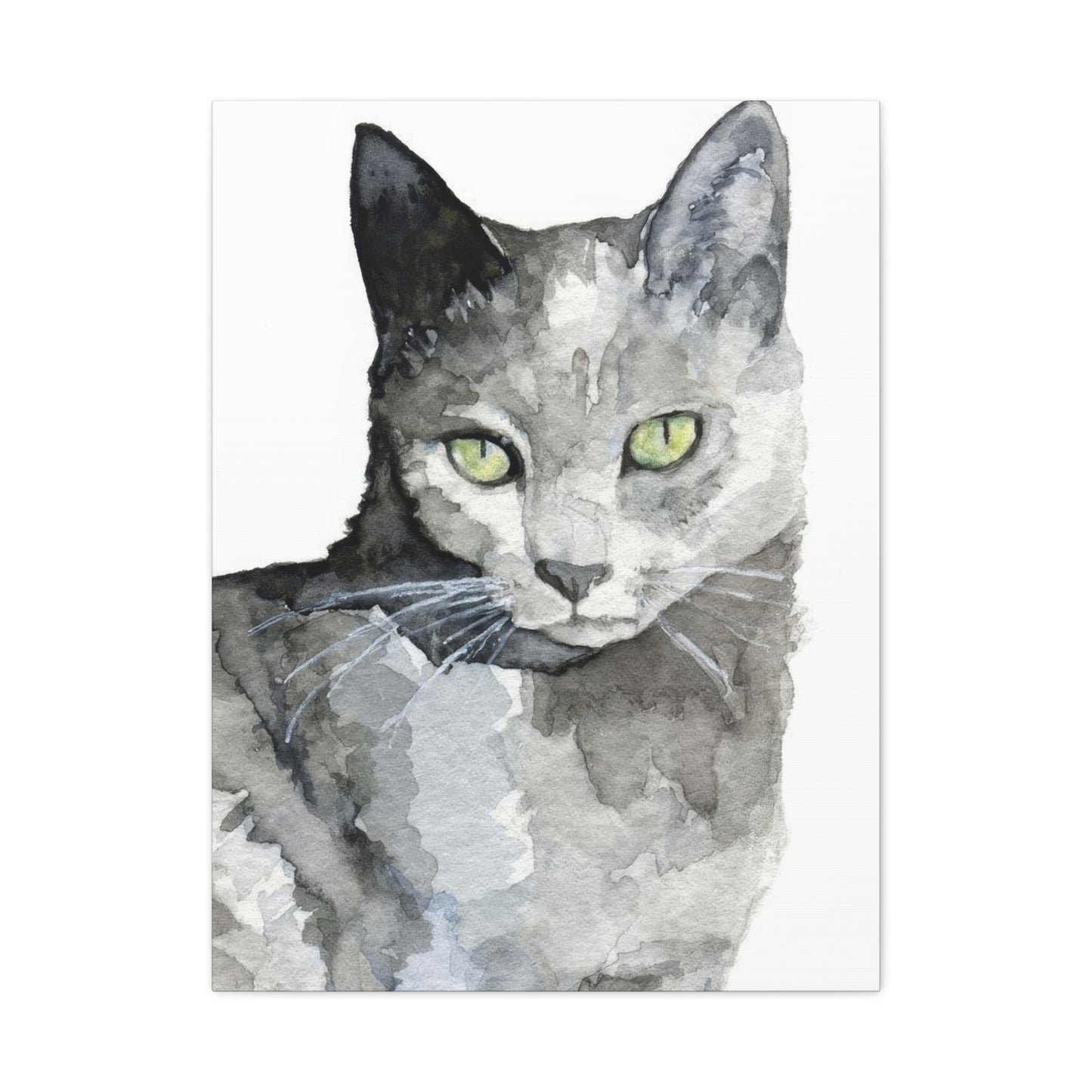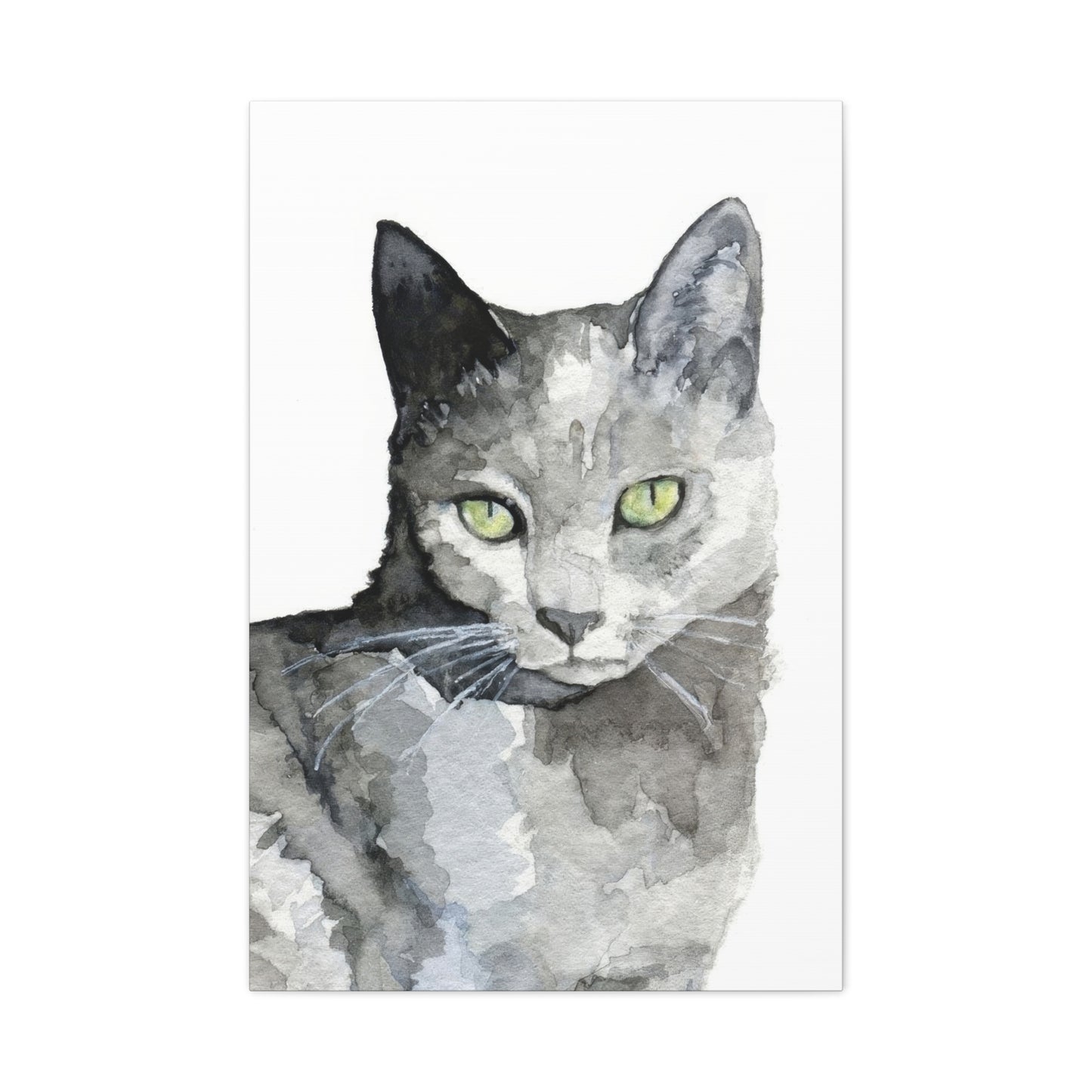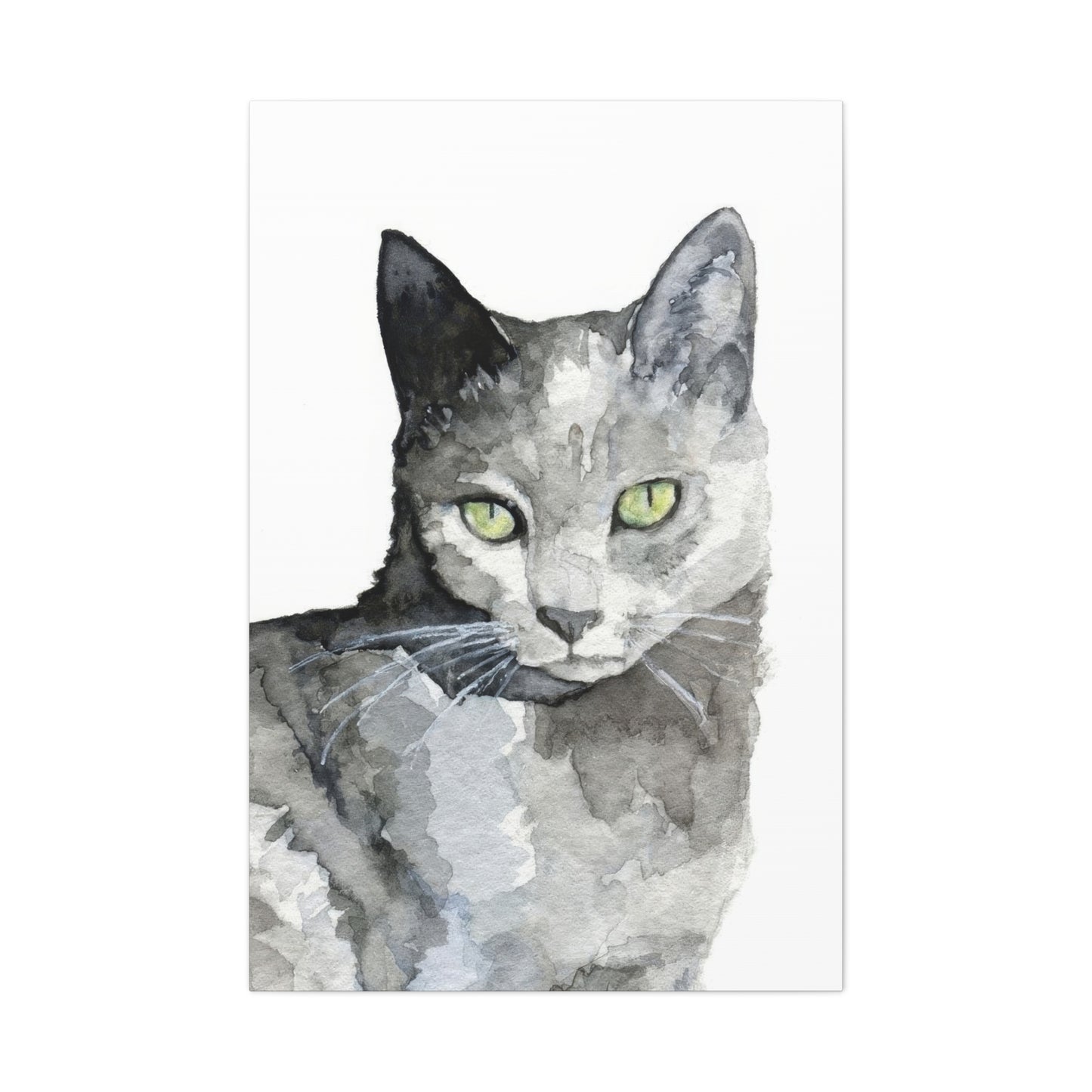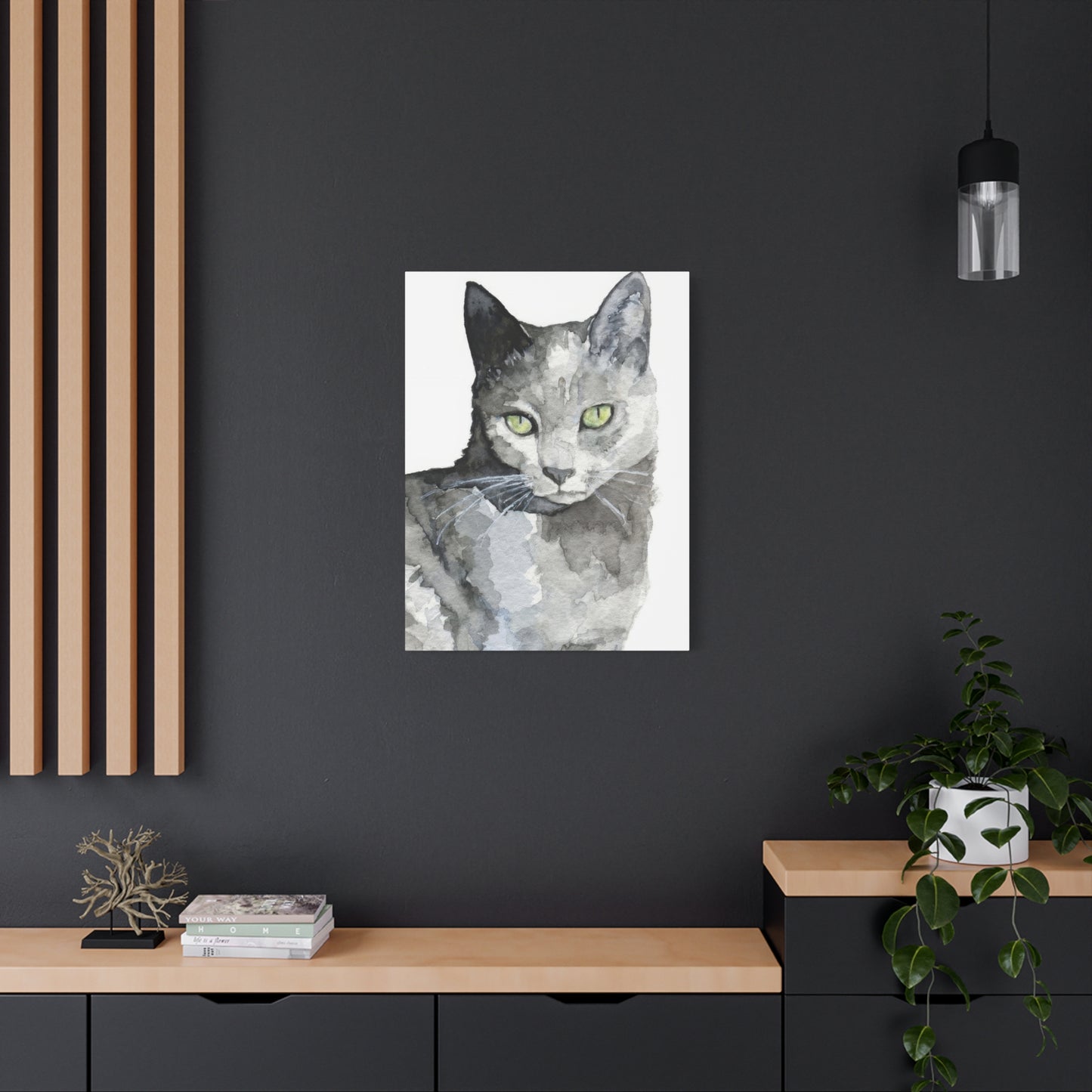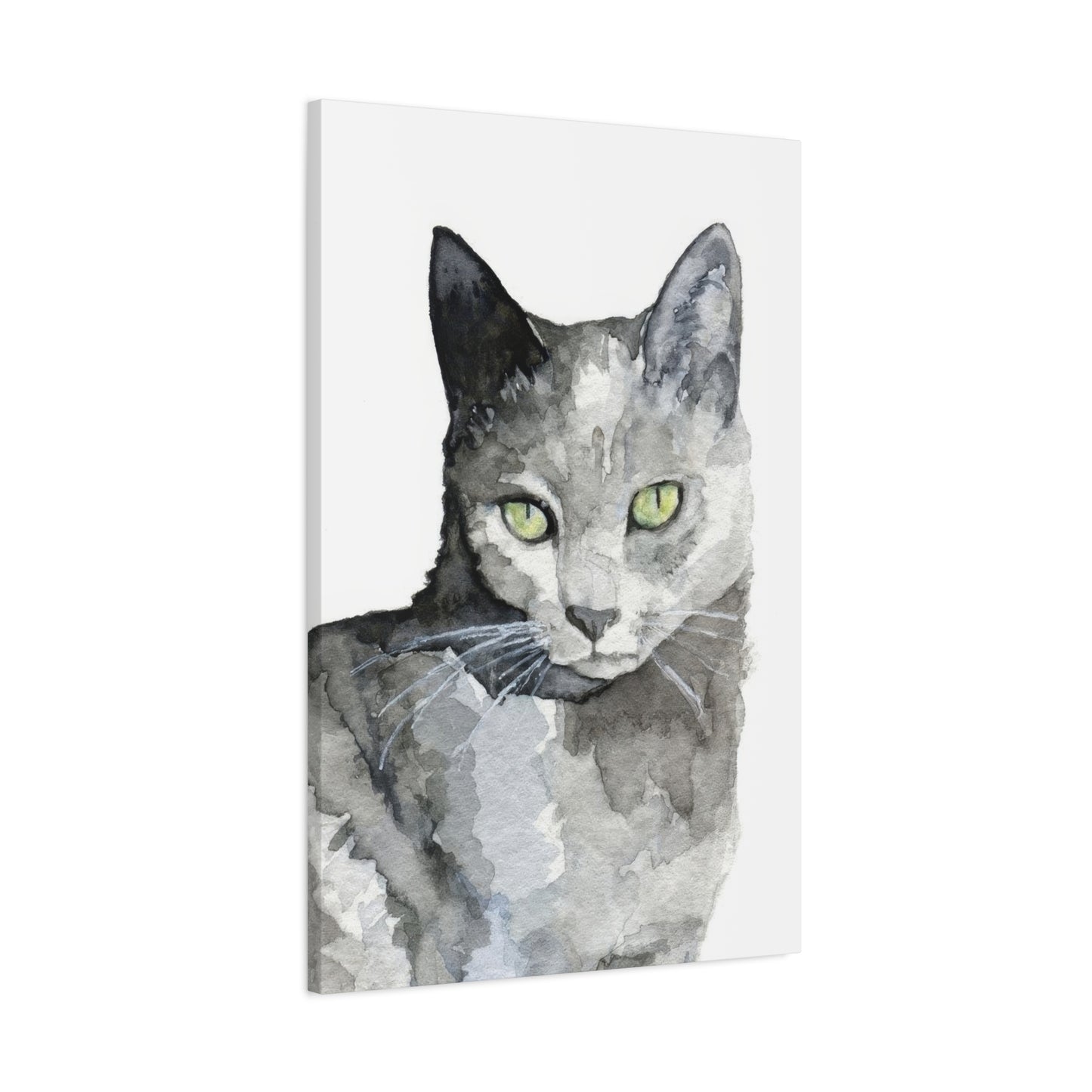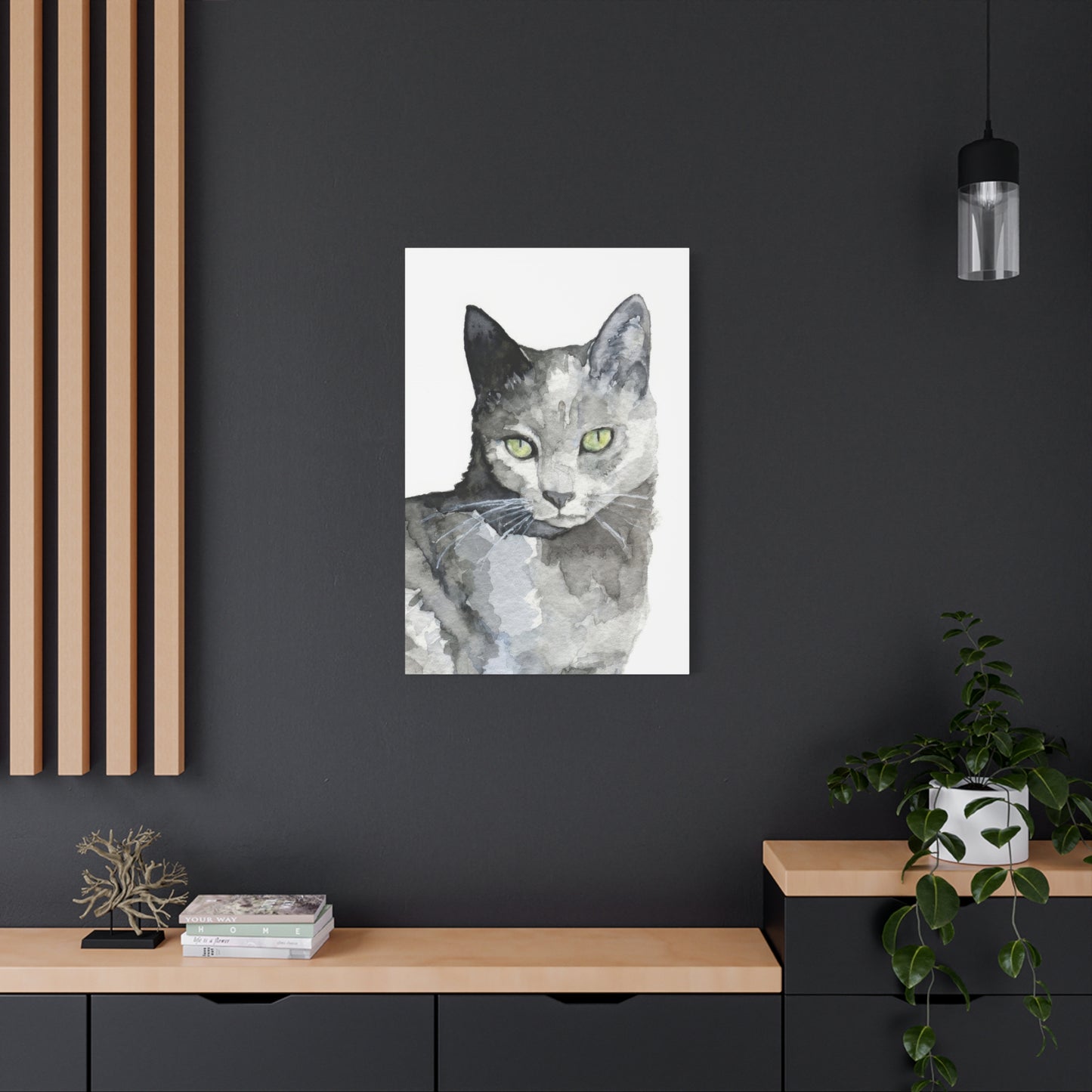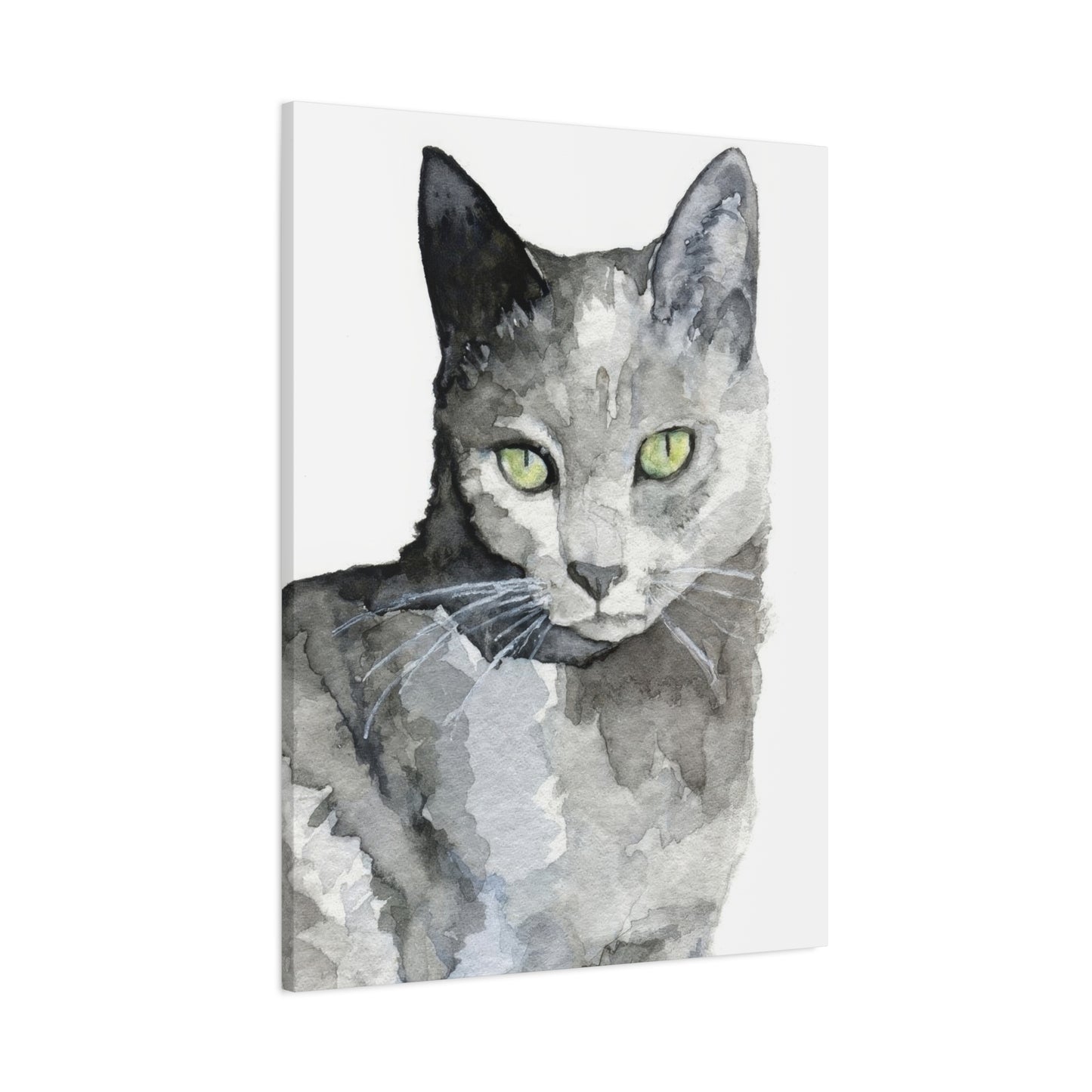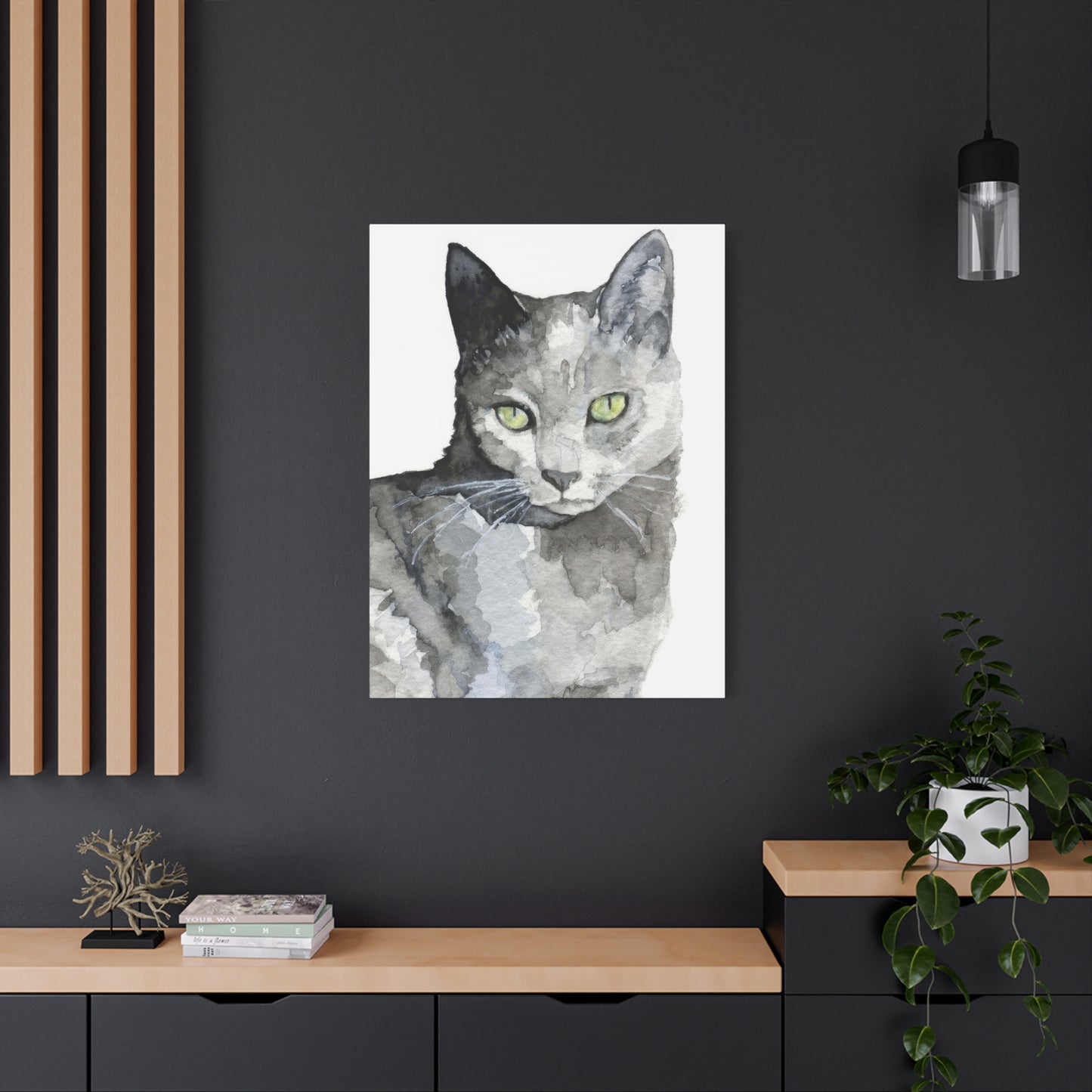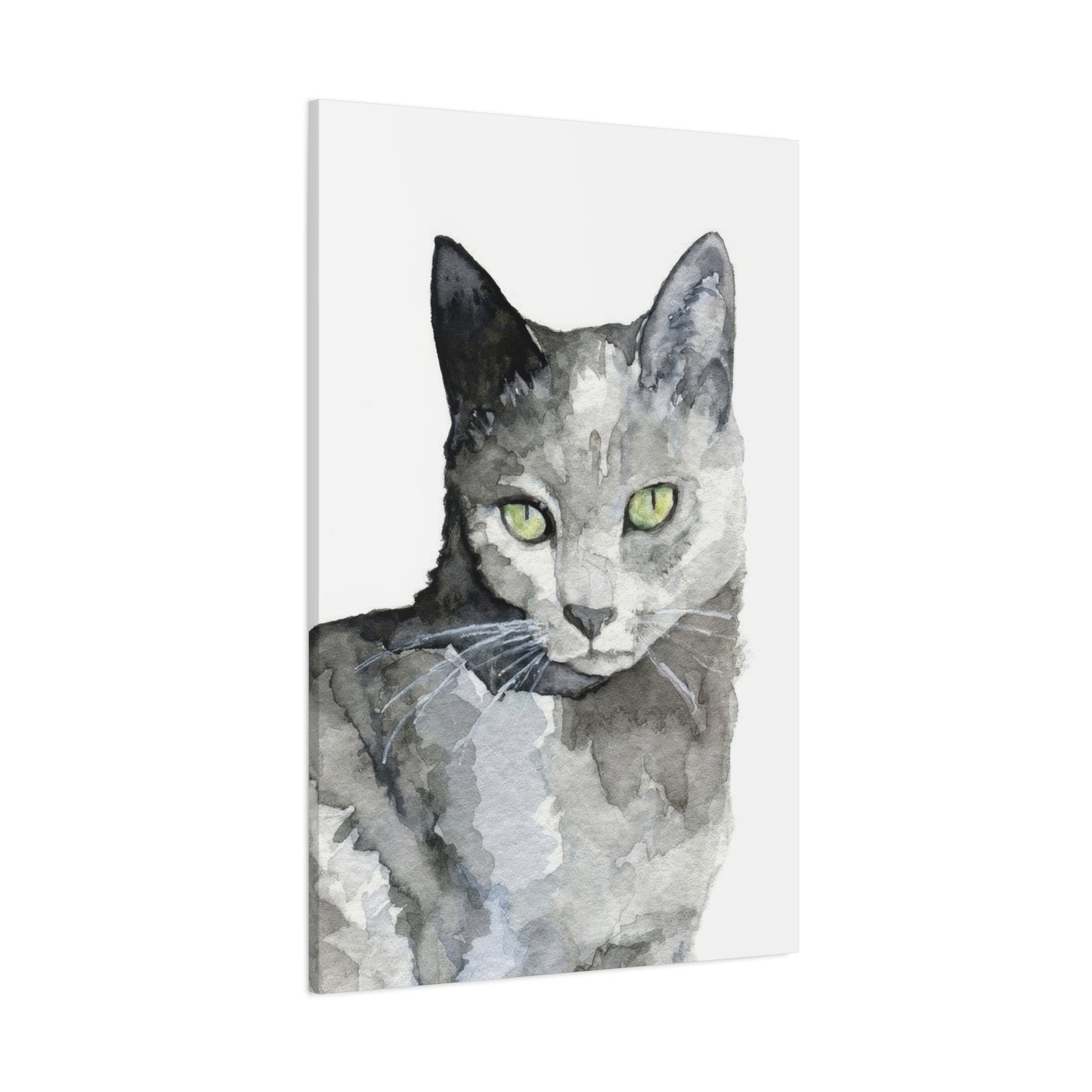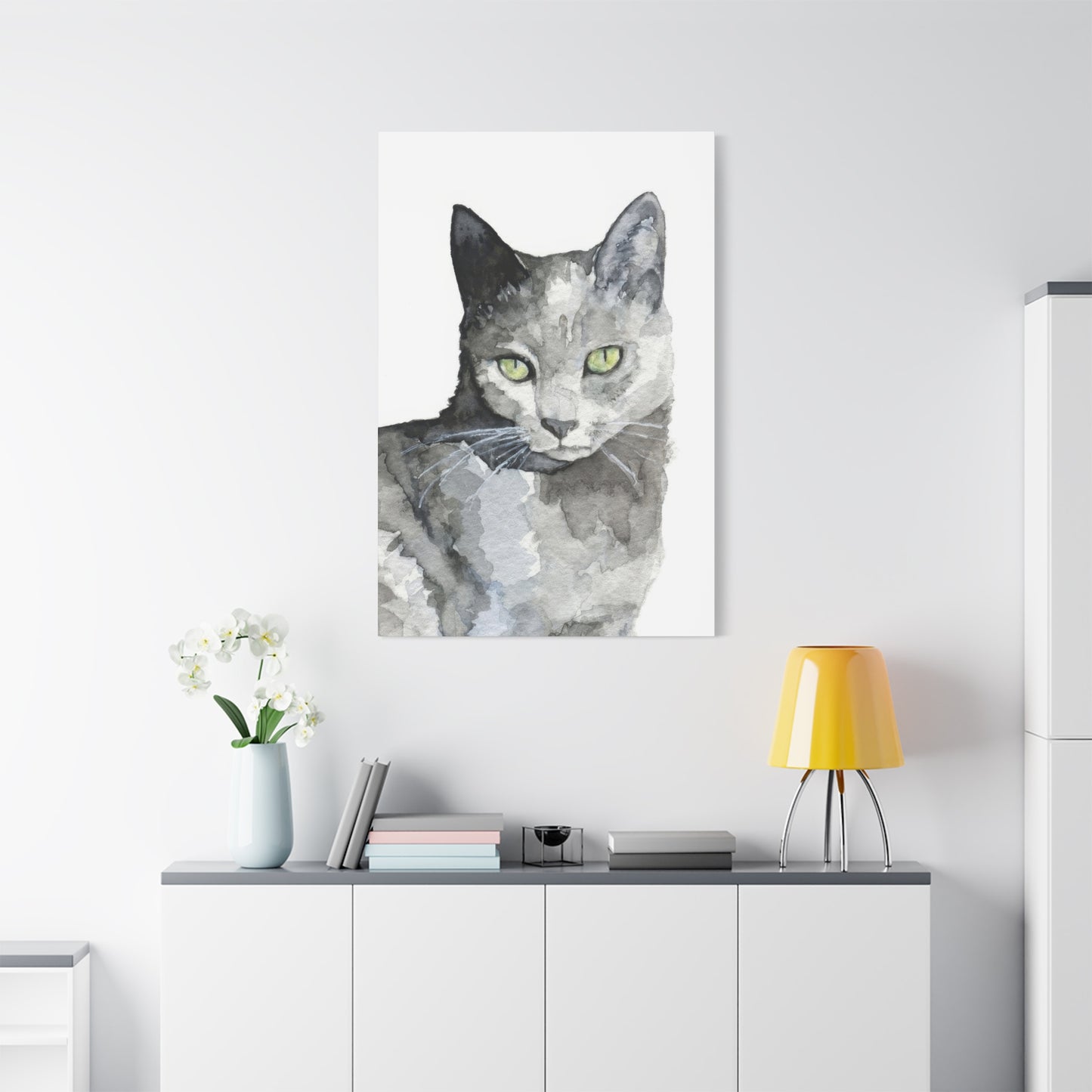Elegant Feline Imagery: Grey Cat Wall art Decorations on Canvas for Modern Interior Spaces
The world of interior decoration has witnessed a remarkable shift toward incorporating animal-themed artwork, with feline imagery emerging as a particularly popular choice among homeowners and design enthusiasts. Grey cat wall art on canvas prints represents a sophisticated fusion of artistic expression and contemporary home styling that resonates with pet lovers and art collectors alike. This comprehensive exploration delves into every aspect of grey cat canvas prints, from their aesthetic appeal to practical considerations for display and maintenance.
Canvas prints featuring grey cats have become increasingly sought after in recent years, offering a perfect blend of elegance and charm that complements various interior design schemes. The neutral tones of grey felines naturally harmonize with both minimalist and maximalist decorating approaches, making them versatile additions to any living space. Whether you're drawn to realistic portrayals, abstract interpretations, or whimsical representations, the market offers an extensive range of grey cat canvas art to suit every taste and preference.
The Timeless Appeal of Feline Artwork in Home Decoration
Throughout history, cats have captivated human imagination and featured prominently in artistic expressions across cultures worldwide. From ancient Egyptian hieroglyphics to contemporary digital art, felines have maintained their position as beloved subjects in visual arts. The enduring fascination with cats in artwork stems from their mysterious nature, graceful movements, and the deep emotional connections people form with these companions. Grey cats, in particular, possess a refined aesthetic quality that makes them especially suitable for sophisticated interior spaces.
The popularity of feline-themed wall decorations reflects a broader cultural appreciation for these animals and their significance in human lives. Pet ownership continues to rise globally, with cats ranking among the most popular companion animals. This widespread affection for felines naturally translates into a desire to incorporate their images into living spaces. Canvas prints offer an accessible and stylish way to celebrate this bond, allowing individuals to surround themselves with imagery that brings joy and comfort to their daily environment.
Grey cats hold a special place in feline appreciation due to their distinctive coloring and the variety of breeds that exhibit this coat color. From the luxurious Russian Blue to the charming British Shorthair, grey-coated cats encompass a wide spectrum of appearances and personalities. This diversity provides artists with rich material for creative interpretation, resulting in artwork that ranges from photorealistic portraits to stylized illustrations. The subdued yet sophisticated palette of grey tones makes these pieces particularly adaptable to various color schemes and decorating styles.
Understanding Canvas Print Technology and Quality
Canvas printing technology has evolved significantly over recent decades, transforming how artwork is reproduced and distributed. Modern canvas prints utilize advanced digital printing techniques that capture intricate details and subtle color variations with remarkable accuracy. Understanding the technical aspects of canvas printing helps consumers make informed decisions when selecting artwork for their homes. The quality of a canvas print depends on several factors, including the resolution of the original image, the printing method employed, and the materials used in production.
Giclee printing represents the gold standard in canvas reproduction, utilizing archival-quality inks and high-resolution printers to create museum-quality reproductions. This printing method employs microscopic ink droplets to achieve exceptional color accuracy and detail preservation. The term giclee, derived from French meaning to spray or squirt, refers to the inkjet process used in these premium prints. When applied to grey cat artwork, giclee printing captures the subtle gradations in fur texture and the nuanced shading that brings feline subjects to life.
The canvas material itself plays a crucial role in the final appearance and longevity of the print. Premium canvas fabrics feature a tight weave that provides a smooth surface for ink absorption while maintaining the characteristic texture that distinguishes canvas from paper prints. Polyester and cotton blends have become popular choices, offering durability and resistance to environmental factors. The weight and thickness of canvas material, measured in ounces per square yard, indicates quality and structural integrity. Heavier canvases typically resist sagging and provide a more substantial feel that enhances perceived value.
Canvas stretching and mounting techniques significantly impact the presentation and durability of finished prints. Gallery wrap mounting, where the printed canvas extends around the sides of the wooden frame, creates a finished look that eliminates the need for additional framing. This contemporary presentation style has gained popularity for its clean, modern appearance and the way it allows artwork to blend seamlessly with various interior designs. The depth of the stretcher bars, typically ranging from three-quarters of an inch to two inches, influences the visual impact and shadow effect of the mounted canvas.
Artistic Styles and Interpretations of Grey Cat Imagery
The artistic representation of grey cats spans an impressive range of styles, from hyperrealistic photographic prints to highly abstract interpretations. This diversity allows consumers to select artwork that aligns with their personal aesthetic preferences and the overall design direction of their spaces. Photorealistic cat portraits appeal to those who appreciate technical mastery and want to capture the authentic beauty of feline subjects. These detailed works often feature individual cats with distinct personalities, creating emotional connections with viewers.
Contemporary abstract interpretations of grey cats offer a different aesthetic experience, focusing on essential forms, gesture, and emotional impression rather than literal representation. Abstract cat artwork might employ bold brushstrokes, geometric shapes, or fluid lines to suggest feline presence and movement. These stylized approaches allow artists to emphasize particular qualities such as grace, mystery, or playfulness while maintaining recognizable feline characteristics. Abstract grey cat prints work particularly well in modern and contemporary interior settings where they contribute to cohesive design narratives.
Minimalist cat artwork has gained considerable traction in recent years, reflecting broader design trends toward simplicity and essential forms. Minimalist grey cat prints might feature single-line drawings, simplified silhouettes, or compositions with abundant negative space. This approach creates visual breathing room and allows the artwork to integrate seamlessly into spaces without competing for attention with other decorative elements. The restraint inherent in minimalist design paradoxically often creates more impactful statements, as viewers focus intensely on the limited elements present.
Vintage and retro-inspired grey cat artwork appeals to those drawn to nostalgic aesthetics or seeking to create eclectic interior schemes. These pieces might emulate the look of mid-century advertising art, Victorian illustrations, or other historical artistic periods. The combination of grey cat subjects with vintage styling creates intriguing juxtapositions that add character and conversation-worthy elements to interior spaces. Distressed or aged finishing techniques applied to canvas prints can enhance the authentic vintage appearance of these works.
Selecting the Appropriate Size for Your Space
Determining the optimal size for canvas prints requires careful consideration of wall dimensions, viewing distances, and the relationship between artwork and surrounding furnishings. An appropriately sized piece creates visual harmony and enhances the overall impact of the artwork. Undersized prints can appear lost on large wall expanses, while oversized pieces may overwhelm smaller spaces. Understanding proportion and scale principles helps ensure that grey cat canvas art makes the intended visual statement.
The relationship between furniture and wall art provides useful guidelines for size selection. A general rule suggests that artwork displayed above furniture should measure approximately two-thirds to three-quarters the width of the furniture piece below it. For grey cat canvas prints displayed above sofas, credenzas, or beds, this proportion creates balanced visual weight and establishes clear relationships between elements. However, these guidelines serve as starting points rather than rigid rules, and personal preference ultimately determines the most satisfying arrangements.
Gallery wall compositions offer opportunities to display multiple canvas prints of varying sizes in cohesive arrangements. Creating gallery walls with grey cat artwork allows for creative expression and can fill larger wall areas more effectively than single oversized pieces. When designing gallery walls, consider the spacing between individual prints, typically ranging from two to four inches. Maintaining consistent spacing creates order and unity, while varied spacing can produce more dynamic, organic arrangements. The overall shape of the gallery wall arrangement should complement the wall architecture and surrounding furnishings.
Room size and ceiling height influence optimal artwork dimensions and placement. In rooms with standard eight-foot ceilings, hanging artwork with the center point at approximately sixty to sixty-six inches from the floor aligns with average eye level and creates comfortable viewing experiences. Rooms with higher ceilings accommodate larger prints and may benefit from slightly elevated placement to maintain visual balance. Consider how the grey cat canvas art relates to architectural features such as windows, doorways, and built-in elements when determining size and positioning.
The Role of Lighting in Artwork Presentation
Lighting dramatically influences how grey cat canvas prints appear and how effectively they function as decorative elements. Proper illumination enhances color accuracy, reveals textural details, and creates appropriate visual emphasis. Understanding lighting principles and options helps create optimal viewing conditions for feline artwork.
Natural lighting provides the most accurate color rendering and changes throughout the day, creating dynamic viewing experiences. North-facing light offers consistent, neutral illumination ideal for artwork display, while southern exposures provide brighter but potentially damaging direct sunlight. East and west-facing light changes significantly from morning to evening, which can be advantageous for creating varied moods but may cause uneven fading over time. Consider how natural light interacts with grey cat prints when selecting placement locations, balancing visibility with preservation concerns.
Artificial lighting solutions range from general ambient illumination to specialized accent lighting designed specifically for artwork. Picture lights mounted directly above or below canvas prints provide focused illumination that highlights the artwork while creating dramatic shadow effects. LED picture lights have become popular choices due to their energy efficiency, low heat output, and excellent color rendering properties. The color temperature of artificial lighting, measured in Kelvins, affects how grey tones appear, with neutral white light around three thousand to four thousand Kelvins typically providing pleasing results.
Track lighting and adjustable spotlights offer flexible options for illuminating grey cat canvas prints in gallery-style arrangements. These systems allow precise positioning and angling of light sources to minimize glare while maximizing visibility. When lighting canvas artwork, aim for even illumination across the entire surface, avoiding hot spots or dramatic shadows that distort the intended appearance. The distance between light sources and artwork affects both the spread and intensity of illumination, requiring adjustment to achieve optimal results.
Integrated lighting solutions incorporated into frame designs or wall systems provide seamless illumination options for contemporary interiors. Backlit canvas panels create luminous effects where the artwork appears to glow from within, though this approach requires special preparation and may not suit all imagery. LED strip lighting installed around the perimeter of canvas prints creates modern halo effects that draw attention while providing ambient illumination. These creative lighting approaches work particularly well with grey cat artwork in modern and contemporary design schemes.
Building Collections and Creating Gallery Walls
Collecting multiple grey cat canvas prints allows for creative expression through curated arrangements and gallery wall compositions. Building cohesive collections requires consideration of artistic style, color palette consistency, and thematic elements that unite individual pieces. Whether creating expansive gallery walls or more modest groupings, thoughtful curation enhances visual impact.
Thematic coherence provides direction when selecting multiple grey cat prints for collection. Collections might focus on a specific artistic style such as minimalist line drawings, photorealistic portraits, or abstract interpretations. Alternatively, themes might center on cat breeds, poses, or emotional qualities conveyed through the artwork. Establishing clear collection parameters prevents scattered acquisitions and creates meaningful relationships between pieces.
Size variation within gallery wall arrangements creates visual interest and dynamic composition. Combining large anchor pieces with smaller supporting prints establishes hierarchy and guides viewer attention through the arrangement. The largest canvas typically occupies a central or slightly off-center position, with smaller pieces arranged around it in balanced configurations. Maintaining an odd number of pieces often produces more visually appealing results than even numbers, which can feel overly symmetrical and static.
Grid arrangements offer structured approaches to displaying multiple grey cat canvas prints of identical or similar sizes. Regular grid patterns create order and contemporary appeal, working particularly well in modern interiors. Grids can be configured in various formations such as two-by-two, three-by-three, or rectangular arrangements depending on available wall space and the number of pieces in the collection. Consistent spacing between prints is crucial for successful grid arrangements, with two to three inches between canvases creating clean, professional appearances.
Organic or salon-style arrangements embrace asymmetry and varied spacing for eclectic, collected-over-time appearances. These less structured approaches suit traditional and transitional interior styles where perfect alignment might feel too contemporary. When creating organic gallery walls, laying out the arrangement on the floor before hanging helps visualize the final composition and allows for adjustments. Maintaining consistent spacing between pieces even in asymmetrical arrangements prevents the display from appearing haphazard.
Sourcing Quality Grey Cat Canvas Prints
Navigating the diverse marketplace of canvas print providers requires understanding quality indicators and reliable sourcing strategies. The proliferation of online retailers and custom print services offers unprecedented selection but also presents challenges in assessing quality before purchase. Informed consumers can identify reputable sources and make purchasing decisions that deliver satisfactory results.
Artist-direct purchases support creative professionals while often providing highest quality and most unique artwork options. Independent artists selling through personal websites, online galleries, or craft marketplaces bring distinctive perspectives and styles to grey cat imagery. Direct artist engagement allows for customization discussions, commission opportunities, and personal connection to artwork origins. While artist-direct purchases may involve higher costs than mass-produced alternatives, they offer exclusivity and support for creative communities.
Established home decor retailers and art print specialists provide curated selections with quality assurances and return policies that protect consumer interests. These businesses typically maintain consistent production standards and offer customer service support for addressing issues. The selection from established retailers may be more limited than custom providers but offers convenience and reliability. Physical retailers allow in-person viewing of samples, which can be valuable for assessing print quality, canvas texture, and color accuracy.
Online marketplaces aggregate offerings from numerous sellers, providing extensive selection and competitive pricing. Major e-commerce platforms host thousands of grey cat canvas print listings from diverse sources worldwide. The challenge in marketplace shopping involves assessing individual seller reliability and product quality from vendor to vendor. Customer reviews, detailed product descriptions, and seller ratings help inform purchasing decisions when buying through marketplaces. Understanding return policies and buyer protection programs provides recourse if products fail to meet expectations.
Local print shops and custom framing businesses offer personalized service and support local economies while providing canvas printing capabilities. Bringing personal photographs or selected images to local providers enables direct communication about specifications and allows examination of material samples before committing to full production. Local businesses may offer competitive pricing, especially when avoiding shipping costs associated with distant providers. Building relationships with local print professionals creates ongoing resources for future artwork needs.
Historical Context of Cats in Art
Understanding the historical relationship between cats and artistic representation enriches appreciation for contemporary grey cat canvas prints. Felines have appeared in human artwork for millennia, with their symbolic meanings and aesthetic roles evolving across cultures and eras. This historical perspective illuminates why cat imagery continues to resonate in modern decorative applications.
Ancient civilizations revered cats and incorporated their images into religious art, decorative objects, and architectural elements. Egyptian culture particularly celebrated felines, associating them with deities and attributing magical properties to them. Cat sculptures, paintings, and hieroglyphic representations from ancient Egypt demonstrate sophisticated artistic skill and cultural significance. The Egyptian aesthetic influence continues to inspire contemporary cat artwork, with stylized forms and decorative patterns appearing in modern grey cat prints.
Medieval and Renaissance European art often featured cats in symbolic roles within religious and secular compositions. During these periods, cats carried varied symbolic meanings, sometimes representing domestic virtue and other times associated with witchcraft or evil. The ambivalent symbolism reflects complex cultural attitudes toward felines during these eras. Despite mixed symbolic associations, artists appreciated cats as aesthetic subjects, capturing their forms with increasing naturalism as artistic techniques advanced.
Japanese artistic traditions embraced cats as subjects for painting, printmaking, and decorative arts. The Japanese appreciation for feline grace and mysterious nature produced iconic works that continue to influence contemporary cat artwork. Ukiyo-e prints featuring cats demonstrate sophisticated composition and stylization that balance realism with decorative appeal. The Japanese aesthetic approach to cat imagery, emphasizing essential forms and elegant lines, resonates with modern minimalist and contemporary design sensibilities.
Modern and contemporary art movements have reimagined cats through diverse stylistic lenses from cubist deconstruction to pop art celebration. Twentieth-century artists explored cats as subjects for formal experimentation while maintaining their appeal as approachable, recognizable imagery. The democratization of art through prints and reproductions made cat artwork accessible beyond elite collectors, contributing to its widespread presence in domestic spaces. Contemporary digital art and photography continue this evolution, creating new possibilities for grey cat canvas prints that blend traditional subject matter with cutting-edge techniques.
The Market for Cat-Themed Home Decor
Commercial market analysis reveals significant and growing demand for cat-themed decorative items, including canvas wall art. Understanding market dynamics provides context for the proliferation of grey cat print options and helps consumers navigate purchasing decisions. The cat decor market segment reflects broader cultural trends and consumer preferences that shape product development and availability.
Pet industry growth drives related markets including pet-themed home decor and accessories. Global pet ownership continues expanding, with cats representing one of the fastest-growing pet categories. The emotional bonds people form with pets translate into willingness to incorporate pet imagery into home environments. Market research indicates strong correlation between pet ownership and purchase of pet-themed decorative items, with canvas prints ranking among popular purchase categories.
Online retail transformation has dramatically expanded access to specialized and niche home decor items including grey cat canvas prints. E-commerce platforms enable sellers to reach global audiences without physical retail presence limitations. This accessibility benefits both consumers seeking diverse options and small businesses or independent artists serving specialized markets. The ability to search, compare, and purchase grey cat artwork from anywhere with internet access fundamentally changed how these products reach consumers.
Social media influence shapes design trends and drives demand for specific styles and aesthetics. Visual platforms showcase interior design ideas and inspire users to recreate appealing looks in their own homes. Cat imagery enjoys particularly strong social media presence, with feline content consistently ranking among most shared and engaged categories. This visibility creates awareness of grey cat canvas prints as decorative options and influences aesthetic preferences toward trending styles.
Price segmentation in the grey cat canvas print market accommodates diverse budget ranges from economy to premium categories. Mass-produced prints available through discount retailers serve price-conscious consumers seeking affordable decorative solutions. Mid-range options balance quality and cost, typically offering improved materials and printing techniques at moderate price points. Premium and luxury canvas prints featuring artist original works, limited editions, or superior production quality command higher prices while attracting collectors and design enthusiasts seeking exceptional pieces.
Matching Artwork to Interior Design Styles
Successfully integrating grey cat canvas prints into various interior design styles requires understanding the defining characteristics and aesthetic priorities of different approaches. Each design style presents distinct opportunities and considerations for incorporating feline artwork. Knowledge of style-specific guidelines helps ensure artwork choices enhance rather than conflict with overall design visions.
Modern interior design emphasizes clean lines, minimal ornamentation, and neutral color palettes where grey cat canvas prints naturally align with style principles. Modern spaces typically feature open floor plans, uncluttered surfaces, and carefully curated decorative elements. Grey cat artwork in modern settings should reflect the style's restraint and sophistication, favoring simple compositions, quality materials, and refined presentations. Abstract or minimalist cat imagery often works particularly well in modern interiors, complementing the style's emphasis on essential forms.
Contemporary design, while sometimes confused with modern style, embraces current trends and incorporates diverse influences from multiple periods and aesthetics. Contemporary interiors feel current and often include bold design statements alongside neutral foundations. Grey cat canvas prints in contemporary spaces might range from photographic realism to experimental mixed media, reflecting the style's eclectic and evolving nature. The flexibility of contemporary design accommodates varied approaches to cat imagery, from understated to dramatic.
Traditional interior design draws inspiration from European decorative periods and emphasizes classic elegance, symmetry, and rich detail. Traditional spaces feature wood furniture, layered textiles, and carefully balanced compositions. Grey cat canvas prints in traditional settings benefit from more formal presentations, often including substantial frames and matting. Imagery might lean toward realistic portraiture or vintage-inspired illustrations that complement the historical references inherent in traditional design.
Transitional design bridges traditional and contemporary aesthetics, creating balanced spaces that feel both current and timeless. Transitional interiors combine the comfort of traditional design with the cleaner lines of contemporary approaches. Grey cat canvas prints work exceptionally well in transitional spaces, as their neutral palette and universal appeal complement the style's balanced nature. Artwork selection in transitional design should avoid extremes, instead favoring moderate approaches that harmonize traditional and modern elements.
Creating Focal Points with Grey Cat Canvas Art
Strategic use of grey cat canvas prints as focal points transforms ordinary walls into engaging visual destinations that anchor room designs. Focal points direct attention, create visual hierarchy, and provide reference points around which other design elements organize. Understanding focal point creation principles helps maximize the impact of feline artwork within interior spaces.
Scale and proportion play crucial roles in establishing artwork as effective focal points. Larger canvas prints naturally command more attention than smaller pieces, making size selection important when focal point creation is the goal. A substantial grey cat canvas measuring forty by sixty inches or larger creates immediate visual impact and clearly signals its intended role as a room's centerpiece. However, smaller prints can function as focal points when displayed in strategic locations or arranged in compelling gallery wall configurations.
Contrast between artwork and surrounding wall color emphasizes focal point status and ensures grey cat prints receive appropriate attention. Dark grey or charcoal cat imagery stands out dramatically against light walls, while lighter grey tones create subtle yet sophisticated focal points on darker backgrounds. The level of contrast should align with overall design intentions, with high contrast creating bold statements and lower contrast producing more understated elegance. Consider how wall color choices either enhance or diminish the visibility and impact of grey cat canvas art.
Lighting emphasis reinforces focal point designation by literally spotlighting featured artwork. Dedicated picture lights, track lighting, or strategically positioned lamps direct attention to grey cat canvas prints while creating dramatic illumination effects. The interplay between light and shadow becomes particularly pronounced with three-dimensional canvas surfaces, adding depth and visual interest. Lighting should enhance without overwhelming, illuminating artwork sufficiently for comfortable viewing while maintaining appropriate ambient light levels throughout the space.
The Environmental Impact of Canvas Print Production
Growing environmental awareness prompts consideration of ecological factors in home decor purchasing decisions, including grey cat canvas prints. Understanding the environmental impacts of canvas production, printing, and shipping helps conscious consumers make informed choices aligned with sustainability values. The canvas print industry has begun implementing eco-friendly practices in response to consumer demand and environmental necessity.
Canvas material sourcing represents the first environmental consideration in print production. Traditional cotton canvas requires substantial water, pesticides, and agricultural land for cultivation. Organic cotton alternatives reduce chemical inputs and promote more sustainable farming practices, though they typically command higher prices. Synthetic canvas materials derived from petroleum-based polymers present different environmental concerns related to fossil fuel dependence and microplastic pollution. Hybrid blends attempt to balance performance, cost, and environmental impact considerations.
Printing ink composition significantly affects environmental footprints and indoor air quality. Solvent-based inks release volatile organic compounds during printing and curing processes, contributing to air pollution and potential health concerns. Water-based and latex ink alternatives reduce VOC emissions and offer safer options for both production workers and end users. Some manufacturers employ vegetable-based inks derived from renewable resources, further reducing environmental impacts. Eco-conscious consumers should inquire about ink types when purchasing grey cat canvas prints.
Manufacturing energy consumption and facility operations contribute to overall environmental impacts of canvas print production. Printing equipment, climate control systems, and facility lighting require substantial energy inputs that may derive from fossil fuels or renewable sources. Some manufacturers prioritize renewable energy use, implement energy efficiency measures, or purchase carbon offsets to mitigate climate impacts. Third-party certifications and manufacturer transparency regarding energy practices help identify environmentally responsible producers.
Packaging and shipping considerations affect the total environmental footprint of canvas print purchases, especially for online orders. Protective packaging prevents damage during transit but often involves plastic films, foam, and cardboard that become waste upon arrival. Some sellers employ recycled or recyclable packaging materials and minimal packaging approaches that reduce waste. Shipping distances and transportation methods influence carbon emissions associated with product delivery, with local purchases generally offering environmental advantages over international shipping.
Grey Cat Breeds and Their Distinctive Characteristics
The world of grey-coated cat breeds offers rich variety that inspires diverse artistic interpretations in canvas print imagery. Understanding breed characteristics helps appreciate the authenticity and accuracy of grey cat artwork while enriching knowledge of feline diversity. Different grey cat breeds possess unique physical attributes, temperaments, and historical backgrounds that artists may reference or emphasize in their work.
Russian Blue cats rank among the most iconic grey breeds, featuring distinctive silvery-blue coats with dense, plush texture. These elegant felines possess vivid green eyes that create striking contrast with their grey coloring. Russian Blues originated in Russia's Archangel region and gained popularity through European breeding programs. Their refined appearance and aristocratic bearing make them popular subjects for formal cat portraits and sophisticated grey cat canvas prints. The breed's consistent coloring and distinctive features provide clear visual identity that artists effectively capture.
British Shorthair cats represent another prominent grey breed, though they appear in various colors. Grey British Shorthairs, often called British Blues, feature dense, crisp coats and rounded body types that create teddy bear appearances. Their large, copper or gold eyes complement grey coloring beautifully. The breed's calm, dignified temperament and substantial build translate into artwork that conveys stability and gentle strength. British Shorthair imagery often emphasizes their characteristic round faces and chunky physiques.
Chartreux cats, an ancient French breed, display blue-grey coats with woolly texture and water-resistant properties. These muscular, medium-sized cats feature distinctive smiling expressions and copper to gold eyes. The Chartreux's hunting heritage and robust build differentiate them from more delicate grey breeds. Artwork featuring Chartreux cats might emphasize their powerful bodies and alert, intelligent expressions. The breed's historical associations with French monasteries add romantic elements to their imagery.
Nebelung cats essentially represent long-haired Russian Blues, featuring silky, medium-length coats in blue-grey tones. Their name derives from German words meaning creature of the mist, referencing their ethereal appearance. Nebelungs possess graceful, athletic builds and the vivid green eyes characteristic of Russian Blues. Artists working with Nebelung subjects can emphasize flowing coat texture and elegant movement. The breed's relative rarity makes them distinctive choices for grey cat canvas prints.
Korat cats originate from Thailand and feature silver-blue coats with distinctive tipping that creates shimmering effects. Their heart-shaped faces and luminous green eyes create memorable appearances. Korats hold cultural significance in their homeland, associated with good fortune and traditional wedding ceremonies. Artwork featuring Korat cats might reference their Thai heritage through compositional elements or styling choices. The breed's compact, muscular build and alert expression convey vitality and awareness.
Seasonal Decorating with Grey Cat Canvas Prints
Incorporating seasonal decorating approaches while maintaining year-round display of grey cat canvas prints requires creative strategies that refresh spaces without constant artwork changes. The neutral nature of grey cat imagery provides versatile foundations that accommodate seasonal accent modifications. Understanding seasonal decorating principles helps maximize enjoyment of feline artwork throughout the year.
Spring decorating emphasizes renewal, fresh colors, and light, airy aesthetics that complement grey cat canvas prints beautifully. Surrounding feline artwork with pastel accent colors, fresh flowers, and lightweight textiles creates seasonal context without altering the artwork itself. Soft pinks, mint greens, and pale yellows harmonize with grey tones while conveying spring freshness. Consider rotating decorative accessories near grey cat prints seasonally while maintaining the artwork as a constant anchor element.
Summer decorating trends toward brighter colors, natural materials, and indoor-outdoor connections that work well with neutral grey cat imagery. Vibrant blue and green accents suggest summer skies and foliage while complementing grey tones. Incorporating natural fiber textiles, botanical elements, and beach-inspired accessories creates seasonal atmosphere around permanent artwork installations. Grey cat canvas prints maintain relevance through summer months as cooling visual elements that suggest shade and comfort.
Autumn decorating embraces warm, rich colors and cozy textures that create interesting juxtapositions with cool grey tones. Rust, burgundy, gold, and deep orange accent colors provide autumn warmth while the grey cat artwork offers visual balance. Layering plush throws, introducing seasonal botanicals like wheat stalks or fall foliage, and incorporating wood elements builds autumn ambiance. The contrast between warm autumn palette and cool grey imagery creates dynamic visual interest.
Winter decorating favors cool metallics, white accents, and sophisticated simplicity that naturally aligns with grey cat canvas prints. Silver and pewter accessories echo grey tones in artwork while adding reflective sparkle. White and cream textiles create snowy associations that complement grey feline imagery. Winter holiday decorating can incorporate grey cat prints into festive displays through coordinating ornament colors and decorative arrangements. The sophistication of grey art suits winter's elegant aesthetic.
Digital Art and Modern Grey Cat Canvas Creation
Contemporary canvas print production increasingly involves digital art creation and manipulation, transforming how grey cat artwork comes into being. Understanding digital art processes illuminates the technical sophistication behind modern canvas prints and reveals creative possibilities unique to digital media. The evolution from traditional art media to digital creation has democratized art production while introducing new aesthetic possibilities.
Digital painting software enables artists to create original grey cat artwork entirely within computer environments using stylus and tablet interfaces. These tools simulate traditional media like oils, watercolors, and pencils while offering unique capabilities impossible with physical materials. Digital artists can work with unlimited undo functions, non-destructive layer editing, and precise color control that streamline creative processes. The resulting digital paintings can be printed on canvas at various sizes without quality degradation, assuming adequate resolution in creation.
Photographic source material frequently serves as basis for grey cat canvas prints, either reproduced directly or manipulated through digital editing. Professional pet photographers capture images specifically intended for canvas reproduction, employing lighting, composition, and technical expertise that optimize print quality. Digital editing software allows enhancement of photographs through color correction, background removal, artistic filtering, and composite creation. The line between photography and digital art blurs as extensive manipulation transforms photographic origins into hybrid creations.
Illustration and vector graphics provide another digital approach to grey cat artwork creation. Vector-based software creates artwork from mathematical curves rather than pixel grids, allowing infinite scaling without resolution loss. This technology suits stylized, graphic approaches to feline subjects with clean lines and bold shapes. Vector illustrations can be printed at any size while maintaining crisp edges and smooth curves, making them ideal for large canvas prints.
Cultural Variations in Feline Appreciation and Imagery
Cultural attitudes toward cats vary significantly across global societies, influencing artistic representation and the meanings associated with feline imagery. Understanding cultural dimensions of cat appreciation enriches interpretation of grey cat canvas prints and reveals diverse perspectives on human-feline relationships. These cultural variations reflect historical experiences, religious beliefs, and societal values that shape how different populations perceive and portray cats.
Japanese culture demonstrates particularly strong feline appreciation visible in art, literature, and popular culture. The maneki-neko or beckoning cat symbolizes good fortune and commonly appears in businesses and homes. Japanese aesthetic traditions emphasize cats' grace, independence, and mysterious qualities through various artistic media. Contemporary Japanese kawaii culture portrays cats in cute, childlike styles that influence global design trends. Grey cat artwork drawing on Japanese influences might incorporate these cultural elements while celebrating feline beauty.
Islamic cultural traditions generally regard cats favorably, with religious narratives portraying positive relationships between the Prophet Muhammad and cats. This cultural backdrop creates contexts where cat imagery carries benevolent associations. Islamic artistic traditions' emphasis on geometric patterns and stylized forms influences decorative applications of animal imagery including cats. Grey cat canvas prints referencing Islamic aesthetic traditions might incorporate pattern work, calligraphy, or stylization consistent with cultural artistic conventions.
European cultural relationships with cats historically mixed reverence and suspicion, with medieval associations between cats and witchcraft creating periods of persecution. However, cats maintained practical value as pest controllers and eventually gained appreciation as companions. European artistic traditions thoroughly documented cats across painting, sculpture, and decorative arts. Contemporary European attitudes embrace cats as beloved companions, reflected in strong markets for cat-themed home decor including canvas prints.
Ancient Egyptian civilization elevated cats to sacred status, associating them with the goddess Bastet and mummifying deceased cats for burial. Egyptian artistic conventions portrayed cats with stylized elegance that continues influencing contemporary feline imagery. The Egyptian cultural legacy contributes to widespread associations between cats and mystery, divinity, and protection. Grey cat artwork invoking Egyptian influences taps into these ancient associations and aesthetic traditions.
Pairing Grey Cat Canvas Prints with Other Artwork
Creating cohesive art collections that include grey cat canvas prints alongside other imagery requires thoughtful curation and compositional awareness. Successfully combining feline artwork with diverse subjects and styles produces visually interesting, harmonious displays that exceed the impact of individual pieces. Understanding pairing principles helps build satisfying art collections that maintain coherence while embracing variety.
Thematic connections provide natural foundations for pairing grey cat prints with other artwork. Animal-themed collections might combine feline subjects with other creatures in complementary styles. Nature photography or botanical prints create thematic relationships with cat imagery through shared references to the natural world. Thematic pairing establishes clear collecting logic while allowing considerable variety within the established framework.
Stylistic consistency creates visual harmony when mixing grey cat artwork with other pieces. Combining multiple photorealistic prints produces cohesive collections with shared aesthetic approaches. Similarly, grouping abstract interpretations, minimalist designs, or vintage-style artwork creates stylistic relationships that unify diverse subjects. Maintaining consistent artistic approaches helps disparate subjects feel related and intentionally curated rather than randomly assembled.
Color palette coordination unifies mixed-subject artwork collections through shared chromatic elements. Grey cat prints naturally suit monochromatic or near-monochromatic collections in grey, black, and white tones. Alternatively, consistent accent colors appearing across different pieces create color-based relationships. A grey cat print displayed alongside abstract art featuring grey and coral tones, for example, connects through shared color elements despite different subjects and styles.
Scale and proportion relationships influence how mixed artwork collections appear when displayed together. Varying sizes create visual interest while maintaining some proportional relationships prevents disjointed appearances. A large grey cat canvas might anchor a gallery wall featuring several smaller complementary pieces. Balancing different sizes throughout the arrangement distributes visual weight and creates dynamic compositions.
The Role of Texture in Canvas Art Appeal
Tactile texture distinguishes canvas prints from paper reproductions and contributes significantly to their aesthetic appeal and perceived value. Understanding how texture functions in grey cat canvas artwork helps appreciate this dimension of the medium and informs selection decisions. The three-dimensional quality of canvas surfaces creates visual and tactile interest that enhances artwork beyond purely two-dimensional image reproduction.
Canvas weave texture provides the foundational tactile character that defines the medium. The visible warp and weft threads create subtle surface patterns that interact with printed imagery. Fine weave canvases offer smoother surfaces that minimize texture interference with detailed images, while coarser weaves produce more pronounced texture that contributes rustic or artistic character. The canvas texture becomes part of the artwork's visual signature, distinguishing it from smooth paper prints or glossy photographs.
Printing technique influences how ink interacts with canvas texture to produce final surface characteristics. Some printing methods deposit ink atop canvas fibers, leaving texture fully visible and contributing to artwork character. Other approaches partially fill the canvas weave with ink, moderating texture visibility while maintaining canvas feel. Heavily saturated areas may obscure canvas texture completely, while lighter tones allow full texture visibility. These variations create subtle surface complexity that rewards close examination.
Gel medium applications and texture enhancements simulate traditional painting techniques in canvas print production. Some manufacturers apply clear gel medium over printed surfaces to create raised brushstroke textures that mimic oil or acrylic paintings. These dimensional applications transform flat prints into tactile objects with authentic painting-like qualities. Gel medium enhancements particularly suit grey cat artwork where texture can suggest fur, add depth to forms, or create focal emphasis.
Varnish and coating applications affect both surface texture and light interaction with canvas prints. Gloss varnishes create smooth, reflective surfaces that modify canvas texture feel while enhancing color depth. Matte varnishes maintain canvas texture more authentically while protecting printed surfaces. Satin finishes offer compromises between gloss and matte characteristics. The varnish selection influences how viewers physically and visually experience grey cat canvas artwork.
Pet Photography Tips for Custom Grey Cat Canvas Creation
Creating custom grey cat canvas prints from personal photographs requires attention to photographic technique and quality standards. Understanding photography basics helps pet owners capture images suitable for canvas reproduction, ensuring satisfying results when transforming snapshots into artwork. While professional pet photography offers advantages, informed amateurs can produce acceptable source material for canvas prints through careful attention to key factors.
Lighting quality fundamentally determines photograph success and suitability for canvas reproduction. Natural light from windows or outdoor settings typically produces the most flattering and accurate results for grey cat photography. Soft, diffused light reveals coat texture and color gradations while minimizing harsh shadows that obscure features. Avoid direct flash photography that creates flat appearances, red-eye effects, and unnatural lighting. Overcast days provide excellent outdoor lighting conditions with natural diffusion that eliminates harsh shadows.
Background selection significantly impacts finished photograph quality and canvas print appearance. Simple, uncluttered backgrounds focus attention on feline subjects without visual competition. Solid-colored walls, neutral fabrics, or softly blurred outdoor settings work well as backgrounds for grey cat photography. Ensure adequate contrast between grey cat subjects and backgrounds to prevent visual merging. Lighter grey cats photograph well against darker backgrounds, while darker grey subjects benefit from lighter background tones.
Camera settings and technical factors influence image sharpness and detail necessary for quality canvas reproduction. Higher resolution settings capture more detail, supporting larger print sizes without pixelation. Fast shutter speeds freeze cat movement, preventing motion blur that ruins otherwise good photographs. Manual focus control or single-point autofocus helps ensure sharp focus on cat faces and eyes rather than other composition elements. Enable RAW file formats when possible to maximize post-capture editing flexibility.
Composition and framing determine how effectively photographs translate into wall art. Consider final canvas proportions when composing photographs, leaving appropriate space around subjects. Center-focused compositions work for formal portraits, while rule-of-thirds positioning creates more dynamic, contemporary arrangements. Capture eye-level perspectives for intimate connection or elevated angles for interesting viewpoints. Include sufficient resolution and composition space to allow cropping and adjustments during canvas preparation.
The Influence of Social Media on Cat Art Popularity
Social media platforms have dramatically influenced public engagement with cat imagery and driven demand for feline-themed products including canvas prints. Understanding social media's role in cat culture reveals broader patterns affecting consumer preferences and market dynamics. The viral nature of cat content across digital platforms creates unprecedented visibility that shapes aesthetic trends and purchasing behaviors.
Cat content consistently ranks among the most viewed and shared categories across major social media platforms. The combination of cute appeal, unpredictable behavior, and relatable personality traits makes cats ideal subjects for viral content. This massive online cat presence familiarizes global audiences with feline imagery and cultivates appreciation that translates into offline product demand. Grey cat canvas prints benefit from this general cultural enthusiasm for cat-related content and imagery.
Influencer culture and lifestyle content creation prominently feature home decor choices including wall art in carefully curated content. Interior design influencers showcasing grey cat canvas prints expose followers to styling possibilities and decorative applications. Pet influencers featuring their own feline companions create aspirational content that inspires followers to celebrate their own pets through custom artwork. The visibility of cat art in influencer content normalizes and promotes these decorative choices.
User-generated content and community sharing enable ordinary consumers to showcase their grey cat canvas prints to wide audiences. Social media platforms facilitate sharing of room makeovers, gallery wall arrangements, and decorating projects featuring feline artwork. This peer-to-peer content often resonates more authentically than commercial advertising, influencing purchasing decisions through relatable examples. Hashtag communities around interior design, pet ownership, and specific cat breeds create niche audiences enthusiastic about related products.
Visual search and discovery features on platforms facilitate finding and purchasing grey cat canvas prints directly from social media apps. Users can identify products featured in images and follow links to purchase similar or identical items. This seamless integration between content discovery and commerce streamlines the path from inspiration to acquisition. Social media platforms increasingly function as visual shopping environments where decorative items including canvas prints can be researched, evaluated, and purchased.
Conclusion:
The remarkable popularity and versatility of grey cat canvas prints reflect multiple converging factors that ensure their continued relevance in interior design and home decoration. Throughout this extensive exploration, we have examined the aesthetic qualities, practical considerations, cultural contexts, and market dynamics that make grey feline imagery such a compelling choice for wall art. The synthesis of these elements reveals why grey cat canvas prints occupy such a significant position in contemporary home decor markets and why they resonate so deeply with diverse audiences.
The fundamental aesthetic advantages of grey cat artwork stem from the inherent beauty of feline subjects combined with the sophisticated neutrality of grey coloring. Grey tones provide versatility that accommodates virtually any color scheme or design style, from ultra-modern minimalism to traditional elegance. This chromatic flexibility means grey cat canvas prints integrate seamlessly into existing decorative schemes while offering sufficient visual interest to serve as focal points when desired. The psychological associations of grey with sophistication, balance, and calm enhance the appeal of these pieces for creating harmonious living environments.
The emotional connections people form with cats translate powerfully into desire for feline imagery in living spaces. Whether celebrating beloved companions through custom portraits or simply appreciating the aesthetic qualities of cat subjects, grey cat canvas prints allow individuals to surround themselves with imagery that brings joy and comfort. This emotional dimension elevates canvas prints beyond mere decoration, transforming them into meaningful expressions of personal identity and values. The biophilic benefits of incorporating animal imagery contribute measurably to occupant wellbeing, validating the choice of cat artwork on both aesthetic and psychological grounds.
Technological advances in canvas printing and digital art creation have democratized access to high-quality grey cat artwork while enabling unprecedented customization options. Consumers today enjoy extensive selection spanning artistic styles, price points, and personalization possibilities that were unimaginable in previous eras. The infrastructure supporting custom canvas production allows transformation of personal photographs into professional artwork, creating unique pieces with deep personal significance. These technological capabilities ensure that grey cat canvas prints remain accessible and relevant to evolving consumer preferences.
The market for grey cat canvas prints demonstrates remarkable resilience and growth potential supported by multiple reinforcing trends. Rising pet ownership, particularly cat adoption, creates expanding audiences naturally interested in feline-themed decor. Social media amplification of cat content maintains high cultural visibility that supports sustained demand. The maturation of e-commerce and online art markets facilitates efficient connections between producers and consumers regardless of geographic location. These market fundamentals suggest grey cat canvas prints will maintain strong commercial viability well into the future.
From practical perspectives, canvas prints offer ideal combinations of visual impact, durability, and value compared to alternative art forms. The substantial presence of stretched canvas artwork creates impressive wall displays without the weight and fragility of framed glass pieces. Canvas prints resist common forms of damage better than paper prints while requiring minimal maintenance. The cost-effectiveness of canvas printing technology delivers museum-quality reproduction at accessible price points, extending art ownership beyond traditional collector demographics.

















